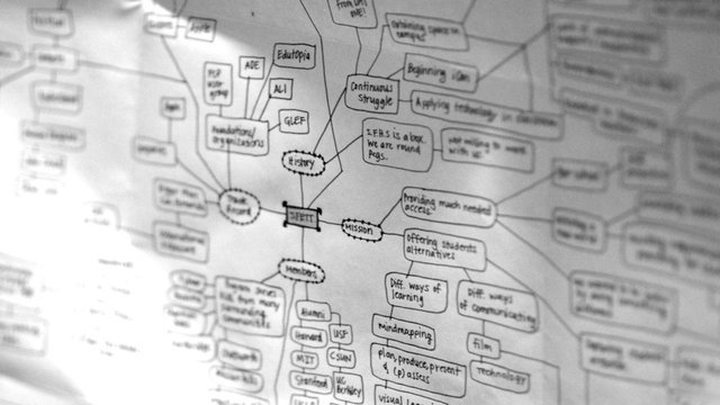Five Best Mind Mapping Tools

Thankfully, there are great tools out there to help you build mind maps, organize them, and save them for later. Here's a look at five of the best, based on your nominations.
Mindjet (Windows/Mac/iOS)

Mindjet is more than just mind mapping software—it's a total suite of applications and tools designed to help you and the people you work with brainstorm, stay on top of projects, collaborate on tasks, and stay organized together. It's more like a complete project management and collaboration suite. It has an extremely powerful mindmapping and brainstorming tool however, designed from the ground up to help you organize your projects, assign different arms of your projects to different people, flesh out all of the individual to-dos and jobs required to make the whole project a success, and it works just as well if you're working with a hundred people, a dozen people, or just organizing your own to-dos. Plus, it integrates with web services and tools you already use, like Microsoft Office, Box,net, and more. Anyone familiar with the old tool MindManager will be happy to learn it's been rolled into Mindjet's individual apps. Most of Mindjet's users are companies willing to pay for it though: It's $15/mo per user for the individual plan, and $30/mo per user for the enterprise plan.
XMind (Windows/Mac/Linux)

XMind has been around for a good long time, and it even made the roundup the last time we looked at mind mapping apps. It hasn't lost its power though; it's still extremely flexible, works great on any desktop OS, and makes it easy to organize your ideas and thoughts in a variety of different styles, diagrams, and designs. You can use simple mind maps if you choose, or "fishbone" style flowcharts if you prefer. You can even add images and icons to differentiate parts of a project or specific ideas, add links and multimedia to each item, and more. If you're a project manager, you can even use XMind's built-in Gantt view to manage tasks in a way your colleagues may be familiar with. Best of all, XMind is completely free and open source. If you have some cash to spend, XMind Plus and XMind Pro offer some additional import/export and presentation features, along with some featured targeted at project managers and businesses who want to use XMind on the enterprise level. Plus will set you back $79 one-time, Pro is $99 one-time, and a subscription to Pro and all of its updates is $79/yr.
Coggle (Webapp)

Coggle is a completely free, simple to use mind mapping tool that's easy to get started with. Sign in with a Google account of your choice and you're off and away. Double-click on any item to edit it, and click the plus signs on either side to add branches to your mind map. Click and hold to drag them around the canvas to design your mind map any way you like. Coggle will automatically assign different colors to your branches, but clicking on a branch will bring up a color wheel so you can personalize it yourself. When you've finished a map, you can download it as a PDF or PNG, share it with others who can just view it or, if you allow it, edit your mind map. You even get auto-saving and revision history, so if you want to see what your mind map looked like before someone you invited started working with it, you can. Best of all? Coggle is completely and totally free.
Freemind (Windows/Mac/Linux)

Freemind is a free, GNU General Public Licensed mind mapping app built in Java, so it runs on just about anything you throw it at. It was the winner of our last poll, partially because of its flexibility, and because its features and performance are pretty consistent regardless of the operating system you use with it. It's a pretty powerful mind mapping tool too, offering complex diagrams and tons of branches, graphics and icons to differentiate notes and connect them, and the option to embed links and multimedia in your mind maps for quick reference. Freemind can export your map as HTML/XHTML, PDF, OpenDocument, SVG, or PNG. Compared to a lot of the newer tools it may look a little dated, but it's still powerful and useful, especially if it's function you're looking for, not form.
MindNode (Mac/iOS)

MindNode is an elegant mind mapping and brainstorming app for OS X and iOS. The iOS version is designed to work well on touch devices, specifically the iPad, and makes it easy to drag branches around, add new nodes, connect nodes, share documents with others, and more. The Mac app is similar, and supports sharing your mind map with others and exporting as PDF and as a Freemind project. MindNode can automatically hide branches that have nothing to do with the items you're working on, embed images and screenshots onto nodes, create links on nodes, and even automatically organize your branches for you if they get messy. It can also support linked mind maps. The UI is relatively clean and hides a lot of its features in order to keep things clean, but that doesn't mean it's not powerful. Many of you who nominated it pointed out it's one of the first mind mapping apps you've seen that really does things right on a tablet. MindNode is $20 for the Mac app, and $10 for the iPhone/iPad app.
Honorable mentions this week go out to Scapple and MindMeister, both of which just missed the top five by one or two votes each. Those of you who nominated them praised them for their ease of use.





